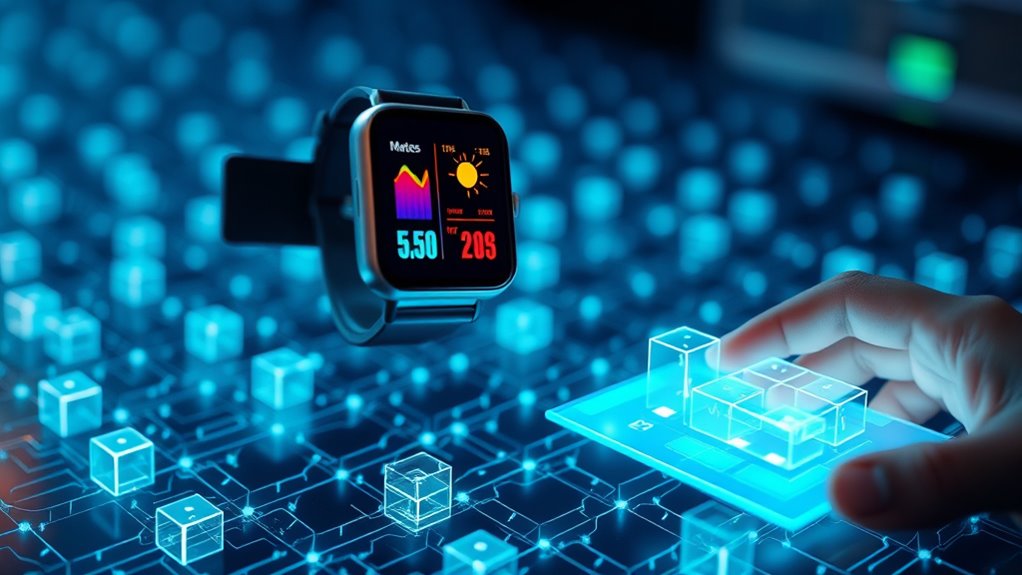Blockchain secures your health data from wearables by offering a decentralized, tamper-proof system that controls who can access your information. It uses cryptographic protocols to guarantee data remains private, unaltered, and only accessible to authorized parties. Smart contracts automate consent and sharing, reducing the risk of breaches and misuse. This technology also provides transparent audit trails, supporting compliance and trust. Explore how these features work together to keep your health info safe and private.
Key Takeaways
- Blockchain decentralizes data storage, reducing the risk of breaches by removing single points of failure.
- It employs cryptographic protocols like encryption and zero-knowledge proofs to protect sensitive health information.
- Immutable records ensure that health data cannot be altered or tampered with, maintaining data integrity.
- Smart contracts automate secure data sharing and access control, allowing only authorized parties to view health data.
- Transparent audit trails enable users and providers to verify data access and sharing, enhancing privacy and compliance.
The Growing Role of Wearables in Healthcare Data Collection
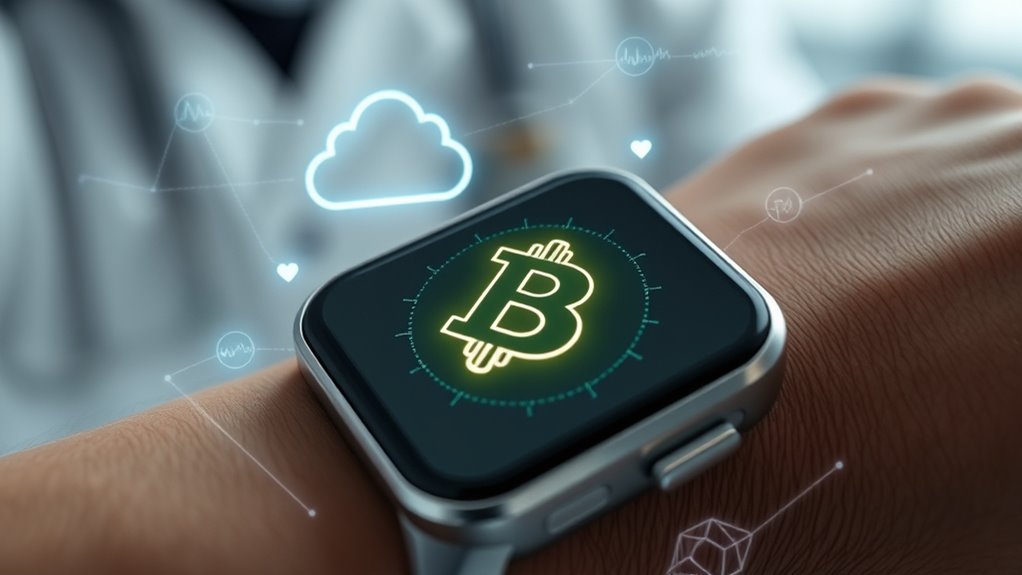
Have you noticed how wearable devices are transforming healthcare data collection? Today, over half of Americans own some form of wearable technology, with around 30% actively using them for health monitoring. In 2020, an estimated 600 million wearables were in use, and that number is projected to rise to nearly a billion soon. These devices continuously track essential health metrics, providing real-time data that supports proactive health management. Nearly 92% of smartwatch users utilize them for fitness and health monitoring, and 88% of physicians encourage patients to monitor their health at home. The pandemic accelerated adoption, with daily use reaching over 43% in early 2025. Wearables are now integral to personal health awareness and large-scale health research, shaping the future of healthcare.
Challenges in Protecting Wearable Health Data
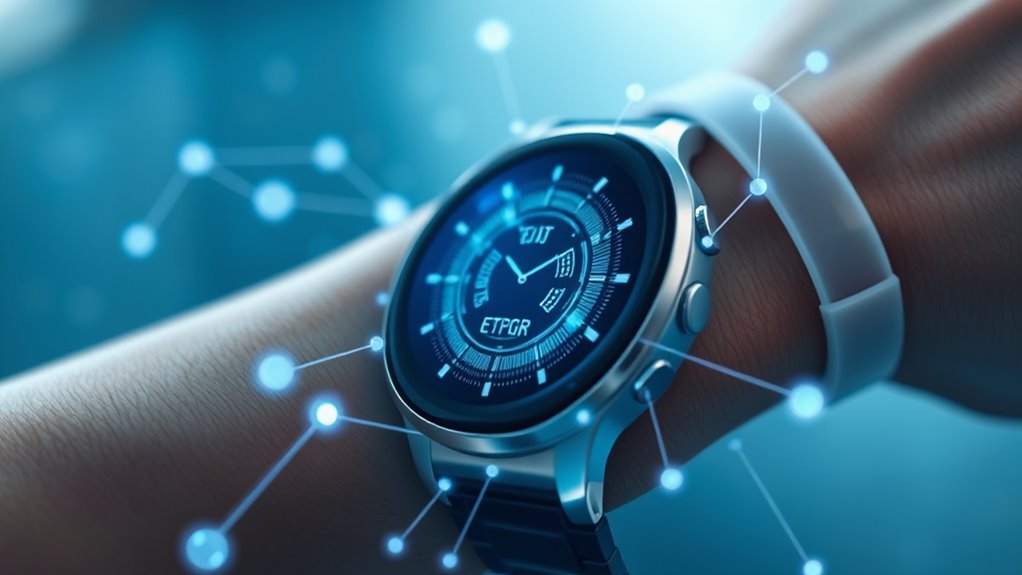
Protecting your wearable health data is becoming increasingly difficult due to rising risks of data breaches and unauthorized access. Many devices store sensitive information outside traditional healthcare regulations, making it vulnerable to exploitation. Addressing these security gaps is vital to guarantee your privacy and control over personal health information. Implementing ethical hacking techniques can help identify and fix vulnerabilities before malicious actors exploit them. Additionally, adopting encryption methods tailored for wearable devices can significantly enhance data security.
Data Breach Risks
Why do wearable health devices remain vulnerable to data breaches despite advances in security? Because vulnerabilities often stem from insecure Bluetooth connections and weak protocols, allowing cybercriminals to intercept sensitive data. When wearables communicate with cloud servers, local device identification leaks can expose your information, especially if security patches aren’t applied. Attackers exploit Bluetooth protocols or unpatched transfer protocols to gain unauthorized access, risking your health data. The rising frequency of breaches—costing the healthcare industry billions—reflects these vulnerabilities. Your personal health metrics, like heart rate and activity, are highly sensitive, making breaches particularly damaging. Third-party data sharing and inconsistent security standards across devices further increase risks, exposing your data to theft, misuse, and privacy violations.
Privacy and Access
Privacy and access to your wearable health data present significant challenges in today’s digital landscape. Many people worry about data security; a 2022 survey shows 40% of consumers are concerned. You might hesitate to share your data with doctors, as privacy fears persist. Wearable data often falls outside HIPAA protections, increasing risks. Devices commonly share data with third-party apps, making privacy harder to control. You may not fully understand how your data is used or who has access, especially when companies or researchers gain entry. Technical vulnerabilities and weak regulations make safeguarding your information even more difficult. Additionally, emerging concerns about AI vulnerabilities highlight that even advanced systems can be exploited, adding another layer of risk to data privacy. Recognizing the importance of trustworthy data practices can help consumers make informed decisions about their health information. Strengthening security protocols and implementing robust encryption methods are essential to protect sensitive health data effectively. The lack of comprehensive regulations often leaves consumers vulnerable to misuse or breaches. Moreover, integrating blockchain technology can offer innovative solutions for enhancing data security and integrity. Balancing the health benefits of wearables with your right to privacy remains complex. Industry accountability, clearer laws, and user awareness are pivotal to overcoming these challenges.
How Blockchain Provides a Secure Framework for Health Records
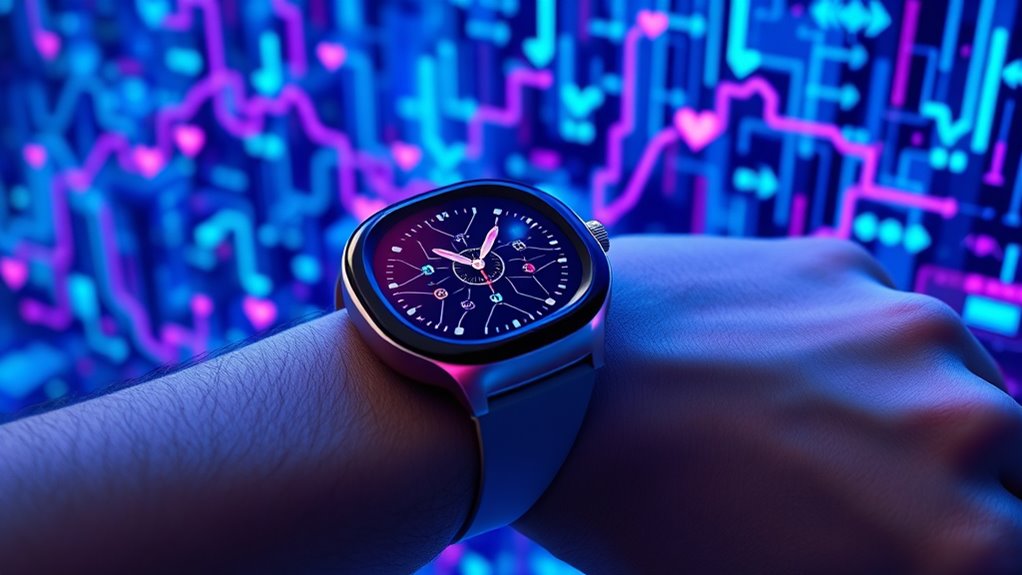
Blockchain offers a robust framework for securing health records by leveraging decentralization, which distributes data across multiple nodes rather than relying on a single central database. This setup minimizes the risk of data breaches and single-point failures, giving you greater confidence in your health information’s safety. No one entity controls the data, fostering trust among patients, doctors, and insurers. Each update or transaction is recorded in a linked block, creating an immutable audit trail that tracks every change. Decentralized consensus mechanisms verify transactions, preventing unauthorized edits. Additionally, distributed ledger technology facilitates interoperability, allowing different healthcare systems to share records securely without intermediaries. This layered approach guarantees your health data remains protected, accurate, and accessible only to authorized parties. Recognizing the importance of Honda Tuning concepts can enhance trust in digital health solutions.
Ensuring Data Integrity With Cryptographic Protocols
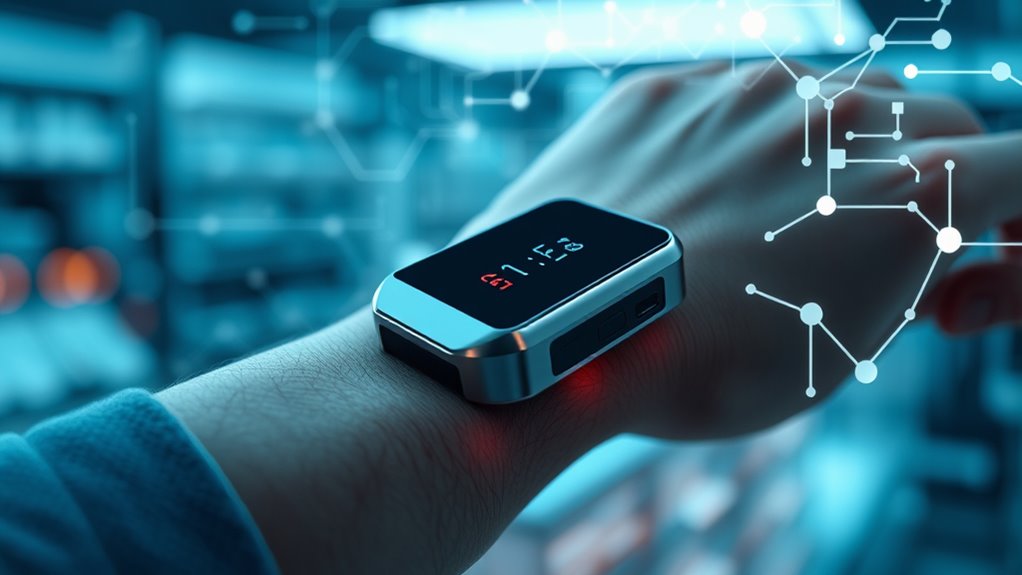
Cryptographic protocols strengthen the security framework by ensuring your health data remains accurate and unaltered during transmission. They use authentication to verify device and user identities, establishing trusted connections. Encryption transforms your wearable data into ciphertext, preventing unauthorized reading and tampering. Both symmetric and asymmetric encryption safeguard data-in-motion and at-rest, maintaining integrity throughout storage and transfer. Protocols also detect modifications by validating checksums or message authentication codes, alerting you if data is compromised. Secure handshake procedures establish encryption parameters and mutual device authentication before data exchange begins. Additionally, cryptographic logs and timestamps record all access and changes, creating tamper-proof audit trails. The use of cryptographic protocols can also help in visualizing and managing your health data securely. These combined measures guarantee your health data’s integrity, making sure it remains trustworthy from device to healthcare provider.
Enhancing Privacy Through Secure Access Controls and Authentication
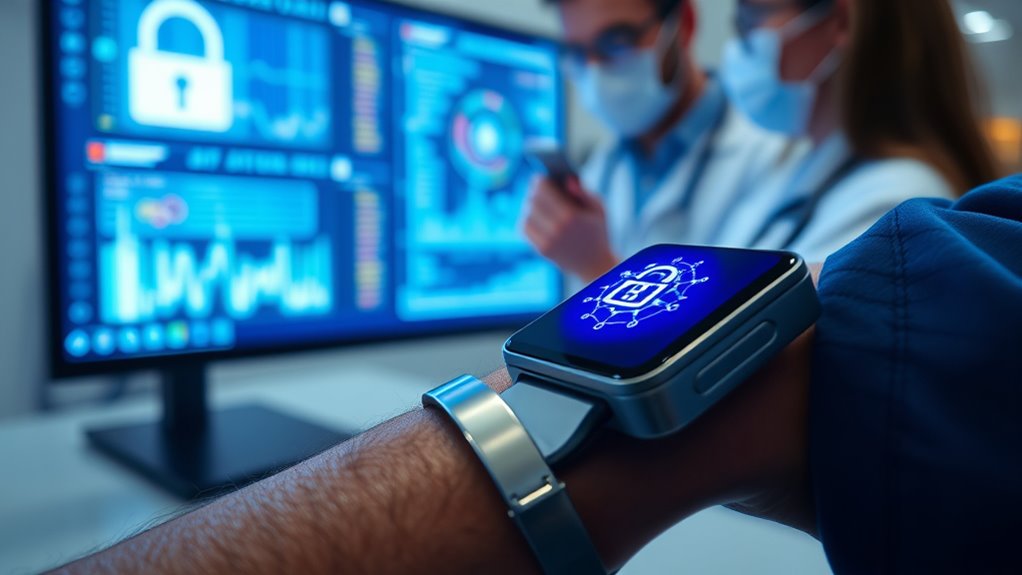
Biometric authentication methods, like fingerprints or heartbeat patterns, reinforce your access controls by verifying your identity with high accuracy. Strict data access protocols guarantee only authorized individuals can view or modify your health information, reducing risks of breaches. Implementing these security measures on blockchain keeps your data private, accessible only when you choose. Additionally, Kia Tuning techniques demonstrate how targeted enhancements can optimize performance and security, illustrating the importance of precise control in both automotive and digital security systems. Emphasizing secure access controls further fortifies your health data against unauthorized access, ensuring your privacy remains intact. As cyber threats continue to evolve, leveraging AI Security Technologies can help detect and prevent potential breaches proactively. Understanding the PlayStation Support Hours ensures timely assistance when managing your connected health devices, reducing downtime and enhancing user confidence. Incorporating astrological compatibility insights may also enhance user confidence in digital health tools by aligning personal traits with security features.
Biometric Authentication Methods
Secure access to your health data relies increasingly on biometric authentication methods that verify your identity seamlessly and continuously. These methods enhance privacy by ensuring only verified users can access sensitive information. Here’s how they work:
- Fingerprint scanners *unseal* devices and authorize transactions with your unique fingerprint patterns.
- Facial recognition analyzes distinct facial features for quick, contactless access.
- Cardiac biometrics capture your heart rhythms via ECG or PPG for ongoing authentication without effort.
- AI biometrics track wrist skin texture, gait, or typing style, enabling passive, real-time verification.
- Biometric security measures are advancing rapidly, integrating with wearable technology to provide even more robust protection.
- High-quality protein sources in dog snacks support overall health and wellness, paralleling secure data practices that promote system integrity.
- The integration of lifestyle habits can also influence the effectiveness of biometric authentication, making user behavior a factor in security protocols.
- Incorporating natural materials in device design can enhance comfort and durability, contributing to user satisfaction and consistent biometric use.
These continuous methods reduce user friction, improve security, and prevent unauthorized access. They operate in the background, providing seamless protection while limiting exposure to data breaches. This multi-layered approach *considerably* enhances your health data privacy.
Strict Data Access Protocols
How can you guarantee that your health data remains private and accessible only to authorized individuals? Blockchain uses strict data access protocols to protect your information. It employs decentralized access control mechanisms, where smart contracts automatically enforce who can view or modify your data, based on your specified permissions. These permissions are recorded immutably on the blockchain, making them tamper-proof and transparent. You retain control, allowing you to update access rights at any time. Data is encrypted, with keys tied to your access policies, ensuring only authorized parties can decrypt it. Every access request is logged as a transaction, creating a clear audit trail that’s impossible to alter. These protocols ensure your health data stays private, secure, and accessible only to those you trust. Additionally, implementing Pimple Patch technology principles, such as targeted treatment and secure absorption, can inspire more secure and efficient data protection methods. Incorporating mindfulness strategies like focused attention during access management can also help users maintain awareness and control over their data security. Furthermore, establishing regular security audits ensures ongoing protection against emerging vulnerabilities. Maintaining awareness of data integrity practices helps prevent unauthorized modifications and preserves the trustworthiness of your health information.
The Use of Smart Contracts for Regulating Data Sharing
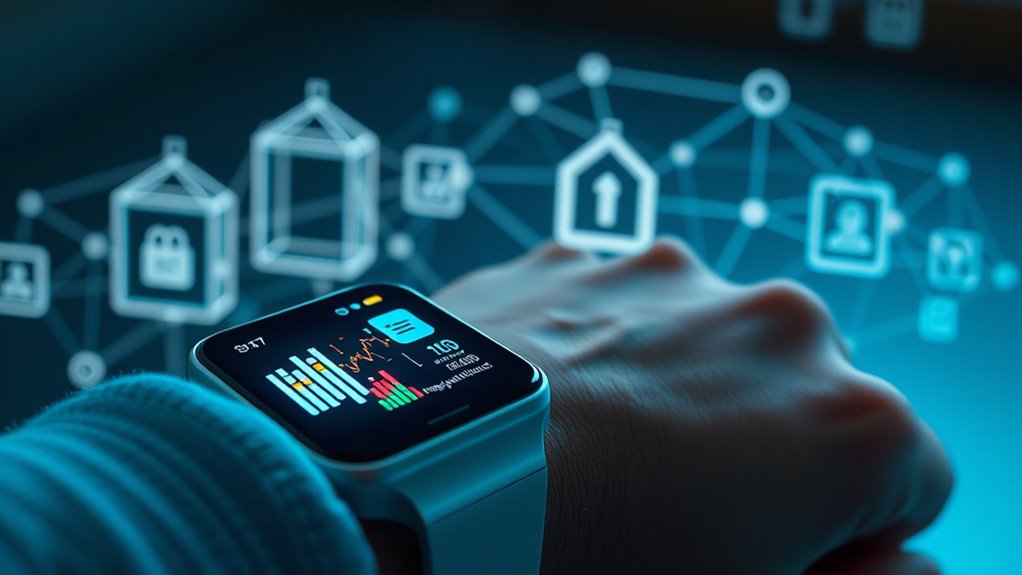
Smart contracts on blockchain play a crucial role in regulating health data sharing by automatically enforcing access rules without needing intermediaries. They securely control who can access your wearable data based on predefined conditions. Here’s how they work:
- Share specific metrics (like heart rate) only during authorized events, such as a doctor’s appointment.
- Automatically revoke access once the event ends or conditions change.
- Streamline insurance claims by linking health data to policy and payment processes.
- Support real-time, verifiable data sharing between providers, insurers, and regulators.
These features ensure transparency, reduce delays, and improve trust, all while safeguarding your privacy. Smart contracts make health data sharing more efficient, secure, and accountable.
Combining Blockchain and Encryption Techniques for Maximum Security

By combining blockchain technology with advanced encryption techniques, healthcare systems can achieve a higher level of data security and privacy. Elliptic Curve Encryption (ECC) secures identities efficiently, preventing unauthorized access while reducing device load. Zero-knowledge proofs authenticate users without revealing sensitive info, maintaining anonymity. Fully Homomorphic Encryption (FHE) allows computations on encrypted data, keeping health details confidential during analysis. Distributed storage with blockchain ensures immutable access records and off-chain data storage, minimizing attack surfaces. Cryptographic functions like hashing, digital signatures, and layered encryption protect data integrity and transmission. This synergy creates a robust security framework, ensuring your health data remains private and safe across wearable devices and healthcare networks.
| Encryption Technique | Key Benefit |
|---|---|
| Elliptic Curve Encryption (ECC) | Secure identities with smaller keys |
| Zero-Knowledge Proofs | Authenticate without exposing data |
| Fully Homomorphic Encryption (FHE) | Compute securely on encrypted data |
Improving Interoperability and Data Management With Blockchain

Blockchain helps you share health data seamlessly across different providers and systems, breaking down traditional silos. It standardizes data formats and uses open protocols to guarantee compatibility among diverse devices and platforms. This technology also keeps your records secure and tamper-proof, giving you greater control over who accesses your information.
Unified Data Sharing
Have you ever wondered how healthcare providers can seamlessly share and manage your health data across different systems and devices? Blockchain enables a unified data sharing model that streamlines this process. It standardizes access and transfer protocols, making data exchange more efficient. With blockchain, you can benefit from:
- Autonomous permission management, giving you control over who accesses your data.
- A single source of truth that reduces confusion and errors.
- Integration of diverse data types—from wearables to medical records—while maintaining integrity.
- Transparent audit trails that improve accountability and trust in data exchanges.
This system simplifies healthcare data management by breaking down data silos, promoting interoperability, and ensuring your health information is accurate, accessible, and secure across all platforms.
Enhanced Data Security
Decentralized architecture plays a crucial role in securing wearable health data, offering a robust alternative to traditional centralized systems. With blockchain’s decentralized ledger, you eliminate single points of failure, reducing the risk of data breaches. Each data block is cryptographically linked, making unauthorized alterations nearly impossible and ensuring data immutability. Multiple participants can verify and authenticate access, boosting transparency and trust. Access control is managed through consensus protocols, allowing only authorized entities to modify data. Every transaction is logged and traceable, enabling real-time monitoring of data use and preventing misuse. Combined with cryptographic protocols like elliptic curve cryptography and zero-knowledge proofs, blockchain enhances identity verification and privacy. Smart contracts automate permissions, making your health data safer and more manageable.
Supporting Regulatory Compliance and Data Transparency
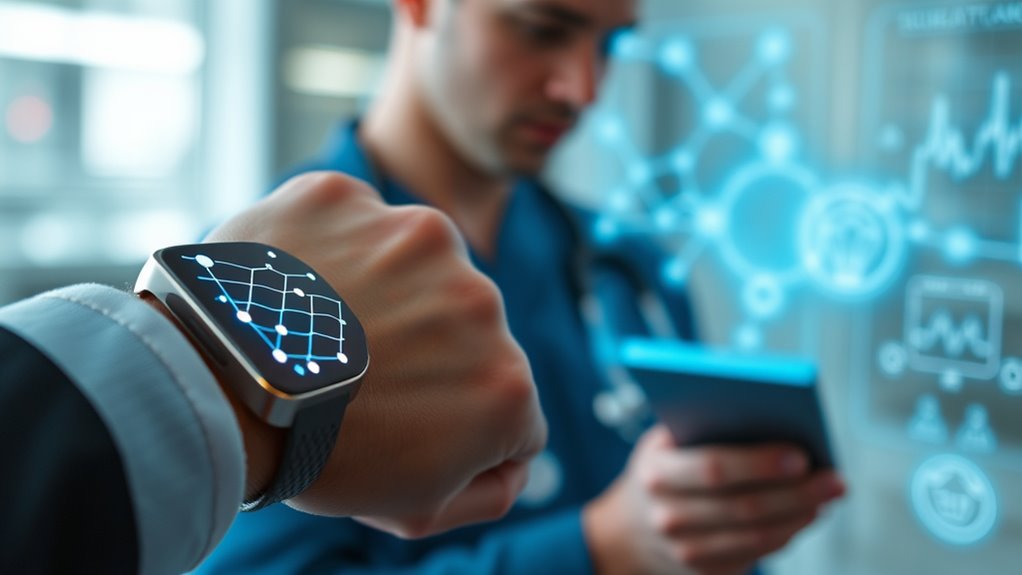
How can wearable health devices meet strict regulatory standards while maintaining transparency? Blockchain makes this possible by providing tamper-proof records and transparent audit trails that simplify compliance with regulations like HIPAA and GDPR. Its decentralized architecture reduces points of failure, lowering breach risks and supporting cybersecurity mandates. Smart contracts automate compliance tasks such as consent management and data sharing, ensuring rules are followed consistently. Cryptographic protocols like elliptic curve encryption enhance identity verification and data privacy.
Blockchain ensures tamper-proof, transparent records for wearable health device compliance, enhancing security and automating regulations.
Consider these key features:
- Immutable ledgers ensure data integrity and support audits.
- Transparent transaction histories promote trust.
- Decentralization enhances security and reduces vulnerabilities.
- Smart contracts automate regulatory workflows for efficiency.
Future Directions in Blockchain-Enabled Wearable Health Data Security

Advancements in blockchain technology are shaping the future of wearable health data security by addressing current limitations and opening new possibilities. You’ll see decentralized data storage that reduces risks of breaches associated with centralized systems. Immutable ledgers will guarantee that your health data remains tamper-proof once recorded. Patient-controlled permission models will let you manage who accesses your data, enhancing privacy. Smart contracts will automate sharing agreements, reducing human error and unauthorized access. Future wearables will adopt lightweight protocols to conserve processing power and battery life. Interoperability standards will enable seamless data exchange across devices and platforms. Additionally, blockchain’s role in advanced analytics and research will grow, supporting secure data sharing and trustworthy AI diagnostics. These innovations will make your health data safer, more private, and easier to control.
Frequently Asked Questions
How Does Blockchain Address the Unique Security Risks of Connected Wearables?
You want to know how blockchain tackles the security risks of connected wearables. It does this by distributing your health data across a decentralized network, reducing the chances of hacking. You control who accesses your data in real-time, thanks to blockchain’s transparent audit trails. Plus, cryptographic protocols ensure your data stays unaltered and tamper-proof, making unauthorized changes or breaches nearly impossible, keeping your health info safe and private.
What Are the Main Privacy Challenges in Implementing Blockchain for Health Data?
You face privacy challenges because your health data ownership often stays with medical centers, not you. When wearables share your info with third parties or store it in the cloud, risks of unauthorized access increase. Without clear consent or control, your privacy can be compromised. Blockchain can help by offering transparent, secure data management, but implementing it requires balancing privacy rights, regulatory compliance, and user trust.
Can Blockchain Solutions Adapt to Rapidly Evolving Healthcare Regulations?
Think of blockchain like a chameleon, constantly adapting to its environment. It can handle rapidly changing healthcare regulations by updating smart contracts and implementing new rules across decentralized networks seamlessly. This flexibility guarantees your health data stays compliant without disruption. You can trust that blockchain’s transparent and immutable system will evolve with regulations, safeguarding your privacy while maintaining data integrity in a constantly shifting legal landscape.
How Scalable Are Blockchain Systems for the Increasing Volume of Wearable Data?
You might wonder how scalable blockchain systems are as wearable data grows. They face challenges like limited transaction speeds and storage capacity, but solutions are emerging. Layer 2 technology, hybrid models, and distributed architectures help improve scalability by processing data more efficiently. Combining blockchain with edge computing and deep learning distributes workloads, making it better suited to handle the increasing volume of wearable health data while maintaining security and compliance.
What Are the Costs and Technical Barriers to Adopting Blockchain in Healthcare?
You need to understand that adopting blockchain in healthcare involves significant costs and technical hurdles. Initial investments can reach millions, including development, software, and upgrades. Ongoing expenses cover maintenance, security updates, and staff training. Technical barriers like system complexity, integration challenges, and the need for expert developers can delay deployment. Plus, managing regulations and ensuring data privacy add further costs and complications, making blockchain adoption a substantial undertaking.
Conclusion
By embracing blockchain, you can stay one step ahead in safeguarding your health data. It’s like having a vault that’s nearly impenetrable, giving you peace of mind in a world full of digital risks. As wearable tech continues to evolve, integrating blockchain guarantees your sensitive information remains private, accurate, and compliant. Don’t put all your eggs in one basket—trust in blockchain’s power to keep your health data secure and your mind at ease.
